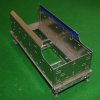mickoo
Western Thunderer
What Steph says is right but you can also deepen the axle countersink and that's what I do, but you have to do it a little more than the wheel.
Pictures...we like pictures
Standard Slaters wheel

Black is the wheel, red the axle and green the retaining screw. The screw grips on the chamfered edge and should not bottom out on the axle end.
Thinned wheel

The axle protrudes more and the retaining screw bottoms out on the axle end leaving a gap twixt wheel and screw, normal procedure here is to skim the end of the axle at the blue line to move the screw down and grip the wheel.
However I prefer to countersink the axle like thus.

When you do it this way you must make sure the axle counter sink is lower than the retaining screw or as Steph says the screw will bottom out on the axle and not grip the wheel. I do it this way for several reasons, primarily it's bloody easier, quicker and quieter, just wind the counter sink in a couple of mm and your done, as it goes in it automatically reduces the height of the square boss on the axle. In addition you don't muller your tool tip turning a square end, none of this dang dang dang as you wind the tool in, and thus quieter.
Another reason for doing it this way, you don't need a lathe, you can mount the axle vertically in a tool vice and drill the counter sink, you could of course also just put the axle in a vice and file the end off, it doesn't need to be square as the faces that do are not the axle end where the screw goes in.
Finally as can be seen in the photos below, you retain more of the square axle end in the corners to hold the wheel, it's not much but every little helps.
Assembled wheel set

Axle end

A trimmed axle end would only be as high as the lowest part of the semi circles on each face.
Both methods are right, it's just which ever you prefer but in both the critical point is that the retaining screw must grip the wheel countersink and must not bottom out on the axle end, how you achieve that is your choice.
Pictures...we like pictures

Standard Slaters wheel

Black is the wheel, red the axle and green the retaining screw. The screw grips on the chamfered edge and should not bottom out on the axle end.
Thinned wheel

The axle protrudes more and the retaining screw bottoms out on the axle end leaving a gap twixt wheel and screw, normal procedure here is to skim the end of the axle at the blue line to move the screw down and grip the wheel.
However I prefer to countersink the axle like thus.

When you do it this way you must make sure the axle counter sink is lower than the retaining screw or as Steph says the screw will bottom out on the axle and not grip the wheel. I do it this way for several reasons, primarily it's bloody easier, quicker and quieter, just wind the counter sink in a couple of mm and your done, as it goes in it automatically reduces the height of the square boss on the axle. In addition you don't muller your tool tip turning a square end, none of this dang dang dang as you wind the tool in, and thus quieter.
Another reason for doing it this way, you don't need a lathe, you can mount the axle vertically in a tool vice and drill the counter sink, you could of course also just put the axle in a vice and file the end off, it doesn't need to be square as the faces that do are not the axle end where the screw goes in.
Finally as can be seen in the photos below, you retain more of the square axle end in the corners to hold the wheel, it's not much but every little helps.
Assembled wheel set

Axle end

A trimmed axle end would only be as high as the lowest part of the semi circles on each face.
Both methods are right, it's just which ever you prefer but in both the critical point is that the retaining screw must grip the wheel countersink and must not bottom out on the axle end, how you achieve that is your choice.
Last edited:

























